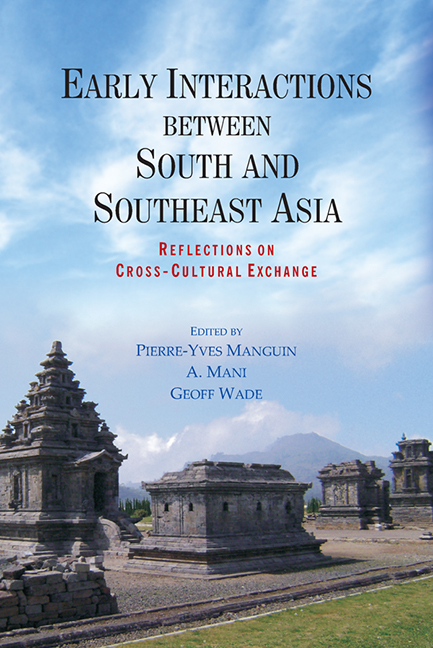Book contents
- Frontmatter
- Contents
- FOREWORD
- Preface
- Introduction
- PART I New Archaeological Evidence from South Asia and Southeast Asia
- PART II Localisation in Southeast Asia
- 11 Tamil Merchants and the Hindu-Buddhist Diaspora in Early Southeast Asia
- 12 The Spread of Sanskrit in Southeast Asia
- 13 The Early Inscriptions of Indonesia and the Problem of the Sanskrit Cosmopolis
- 14 Indian Architecture in the ‘Sanskrit Cosmopolis’: The Temples of the Dieng Plateau
- 15 The Importance of Gupta-period Sculpture in Southeast Asian Art History
- 16 Individuals under the Glaze: Local Transformations of Indianisation in the Decorative Lintels of Angkor
- 17 Early Musical Exchange between India and Southeast Asia
- 18 Buddhism and the Circulation of Ritual in Early Peninsular Southeast Asia
- 19 Early Buddhism in Myanmar: Ye Dhammā Inscriptions from Arakan
- 20 Hindu Deities in Southern Vietnam: Images on Small Archaeological Artefacts
- 21 ‘The Depositing of the Embryo’ – Temple Consecration Rituals in the Hindu Tradition of South and Southeast Asia: A Study of the Textual and Archaeological Evidence
- 22 Localisation of Indian Infl uences as Refl ected in the Laotian Versions of the Ramayana
- 23 Broken Threads: Contested Histories of Brahminism in Cambodia and Thailand and the Construction of Ritual Authority
- LIST OF CONTRIBUTORS
- INDEX
20 - Hindu Deities in Southern Vietnam: Images on Small Archaeological Artefacts
from PART II - Localisation in Southeast Asia
Published online by Cambridge University Press: 21 October 2015
- Frontmatter
- Contents
- FOREWORD
- Preface
- Introduction
- PART I New Archaeological Evidence from South Asia and Southeast Asia
- PART II Localisation in Southeast Asia
- 11 Tamil Merchants and the Hindu-Buddhist Diaspora in Early Southeast Asia
- 12 The Spread of Sanskrit in Southeast Asia
- 13 The Early Inscriptions of Indonesia and the Problem of the Sanskrit Cosmopolis
- 14 Indian Architecture in the ‘Sanskrit Cosmopolis’: The Temples of the Dieng Plateau
- 15 The Importance of Gupta-period Sculpture in Southeast Asian Art History
- 16 Individuals under the Glaze: Local Transformations of Indianisation in the Decorative Lintels of Angkor
- 17 Early Musical Exchange between India and Southeast Asia
- 18 Buddhism and the Circulation of Ritual in Early Peninsular Southeast Asia
- 19 Early Buddhism in Myanmar: Ye Dhammā Inscriptions from Arakan
- 20 Hindu Deities in Southern Vietnam: Images on Small Archaeological Artefacts
- 21 ‘The Depositing of the Embryo’ – Temple Consecration Rituals in the Hindu Tradition of South and Southeast Asia: A Study of the Textual and Archaeological Evidence
- 22 Localisation of Indian Infl uences as Refl ected in the Laotian Versions of the Ramayana
- 23 Broken Threads: Contested Histories of Brahminism in Cambodia and Thailand and the Construction of Ritual Authority
- LIST OF CONTRIBUTORS
- INDEX
Summary
INTRODUCTION
From the end of the nineteenth century and more often in the early part of the twentieth century, remains of ancient Oc Eo culture have been discovered by French scholars in southern Vietnam. Many of these artefacts are Hindu sculptures (Malleret 1959). A number of deity images were also found from surveys and excavations conducted by the Vietnamese since then (Le Xuan Diem et al. 1995: 284-328; Dao Linh Con 1997: 673; Bui Phat Diem et al. 2001). So far, around 200 sculptures and fragments have been found from various archaeological sites in various topographical areas and datable to long chronological time periods. Despite the rich variety of types of sculpture, the Hindu pantheon is only represented by a few gods and goddesses. We mainly meet with images of Vishnu and Shivalinga, and fewer images of Ganesha, Surya, Brahma, or the goddesses Mahishasuramardini and Lakshmi. Only a few images of Shiva and Harihara were found, though a number of fragments make it difficult to identify the iconographical feature of gods and goddesses. We can nevertheless say that these stone sculptures are simple in character and may have played an important role in a somewhat impoverished Hindu pantheon (Le Thi Lien 2006a: 198-204, 209).
On the contrary, a large number of tiny artefacts, particularly gold plaques, appear to represent a much richer number of Hindu deities and more complex iconographic features. In order to provide a reliable source for the study of Hindu iconography and of the beliefs of the ancient people in southern Vietnam, the gold plaques found in situ in the architectural remains are focused on in this paper.
There are several problems that prevent us from clearly identifying and classifying the whole collection at this stage of our study. Some of the important sites have been excavated a long time ago and it is difficult to make an eye-observation of the real artefacts or to identify clearly the images from the photographs. Archaeological reports of the most recent excavations are also in process of preparation, which make it difficult to see the whole picture of one site or a group of sites.
- Type
- Chapter
- Information
- Early Interactions between South and Southeast AsiaReflections on Cross-Cultural Exchange, pp. 407 - 432Publisher: ISEAS–Yusof Ishak InstitutePrint publication year: 2011

